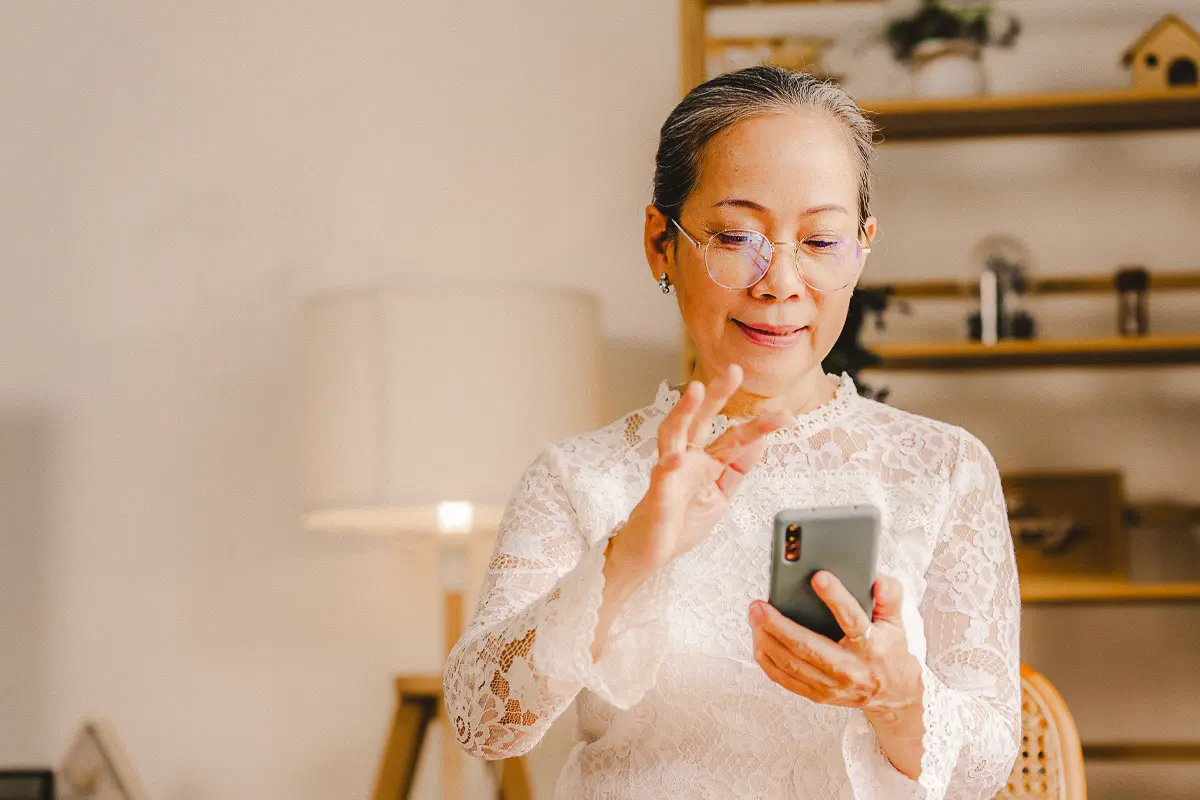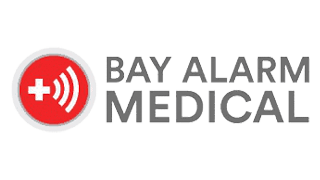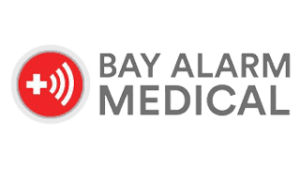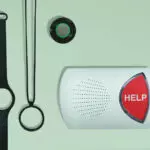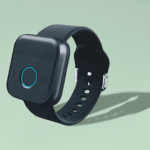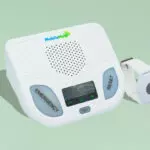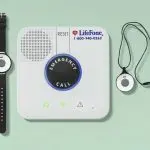Table of Contents
Convincing your care recipient to use a medical alert system—or getting used to using one yourself—can be challenging. Many users feel like their independence is being taken away if they need to use a medical alert system. However, studies have shown the opposite to be true. As well as an improved sense of security, many older adults actually feel an increased ability to live independently when they use a medical alert system. The majority of users say they were able to maintain their lifestyles, stay social, and resume activities they had enjoyed before getting a medical alert system, all important aspects for measuring good mental health.
A medical alert bracelet can be used as an at-home or on-the-go device that connects to a 24/7 monitoring center during an emergency. It can be a more discreet option than some pendant-style necklaces or mobile systems, since it can be easily tucked beneath a shirt sleeve. While medical alert bracelets are less obvious, most don’t support fall detection, which may be a drawback when shopping for a medical alert system.
“The main issue I see is that not all devices have fall detection,” says Nancy Mitchell, a registered nurse and geriatric director of care in Atlanta. “For those [devices] that don’t, the person must use the button to request help. These devices may not be helpful in cases where the person faints … so there’s still some risk of relying on a medical alert bracelet to keep tabs on your loved ones.”
Medical alert bracelets are not the same as medical ID bracelets. Medical ID bracelets show a wearer’s important medical information needed during an emergency, such as allergies, blood type, medical conditions, and current prescribed medication. Unlike medical alert bracelets, medical ID bracelets don’t connect to a 24/7 monitoring center. They can be crucial during an emergency, but they can’t summon help.
Our Handbook Team has tested more than 10 medical alert bracelets. We evaluate each product’s comfort, style, functionality, features, and price and narrowed down the top four to help you find the right one.
Best medical alert bracelet overall
The Bay Alarm Medical SOS Home Cellular is our top pick medical alert bracelet due to its simple but stylish design and easy setup and testing instructions. Bay Alarm Medical also offers “Bella Bands,” a colorful optional band that makes the bracelet look more like jewelry than a medical alert device.
What our Handbook Team says are the best medical alert bracelets
- Bay Alarm Medical SOS Home Cellular: Best overall
- Medical Guardian MGMini Lite: Easiest to use
- MobileHelp Classic: Lowest starting price
- LifeFone At-Home Cellular: Best for check-in services
Compare the best medical alert bracelets
| Starting monthly fee | $39.95 | $44.95 | $24.95 | $43.95 |
| Fall detection cost | $10/month | $10/month | $11/month | $5/month |
| Connection type | Cellular LTE | Cellular LTE | Cellular LTE | Cellular LTE |
| Range (feet) | 1,000 | Unlimited | 1,400 | 1,300 |
| Bracelet battery life | Up to 5 years (at-home bracelet) | 1–3 days (MGMini Lite; at-home and on the go) | 3–5 years (at-home bracelet) | 1–3 years (at-home bracelet) |
Our testing experience




When shopping for a medical alert system, you can only learn so much information by searching a brand’s website or speaking with a sales representative. You can get a general idea of features, but you won’t know what it’s like to use it. Is it simple to set up the base station? Is the help button bracelet comfortable to wear? How easy are the buttons to press?
That’s why we did the testing for you. We want to provide the most helpful information about our favorite medical alert systems based on our experiences.
The Handbook Team tested 28 medical alert systems across 10 brands:
- Bay Alarm Medical
- GetSafe
- HandsFree Health
- LifeFone
- Lifeline
- Lively
- Medical Care Alert
- Medical Guardian
- MobileHelp
- UnaliWear
We consider well-known brands with a generally positive reputation when choosing medical alert systems to test. Our team picks brands with various pricing options, device designs, and safety features.
Our testing process looks like this:
The Handbook Team goes through a checklist of 30 questions while setting up and testing each medical alert system. As part of this, we follow each device’s user guide and note what is intuitive or difficult about the setup process.
From our tester
“The MobileHelp Classic has super simple directions with large pictures and fonts. The Quick-Start Guide is larger than others and is super simple to follow.”
We spend the majority of our testing calling the monitoring center since this is the most important feature of any medical alert system. If the device has fall detection, we attempt six additional calls with fall detection tests.
From our tester
“For all fall tests, we wait 60 seconds with the device still on the ground before claiming whether the test was successful. Many fall detection devices don’t register a fall if it’s followed by sudden movement.”
While it’s difficult to duplicate true falls in a test environment, and more real-world fall data is necessary for a standard accuracy rate of fall detection devices, we want to test fall detection accuracy with a uniform testing method.
Our team conducts three “slow” and three “fast” test falls while wearing the fall detection device. We start all slow falls by sitting in a chair at 90 degrees and dropping to our knees before falling face down on a mat.
For the fast fall, we drop the device from shoulder height to the mat to replicate a fast, hard-impact fall.
“Generally speaking, a hard fall is a fall that can be difficult to stop, happens quickly, and results in a strong impact to the body,” says Sean Marchese, a registered nurse with more than 20 years of experience. “A slow fall is a fall that occurs more gradually, and the impact is likely weaker. However, individuals are not immune to injury after a slow fall.”
If you or your care recipient have a higher risk of falling, Marchese recommends being proactive and speaking with your doctor about assistive devices and prevention strategies.
Read more about our medical alert testing methodology.
What you need to know about medical alert bracelets
Here are the five most important things to know about medical alert bracelets.
Best Medical Alert Bracelets Reviewed in 2024
Best Overall: Bay Alarm Medical SOS Home Cellular
Our verdict
The Bay Alarm Medical SOS Home Cellular is another simple option, with a large red “HELP” button on the base station and step-by-step testing instructions. While the medical alert bracelet doesn’t have fall detection, we are impressed with the fall detection necklace—it detected all six of our test falls.
Insights from our testers
The Bay Alarm SOS Home is an at-home medical alert system that includes a bracelet. When wearing the medical alert bracelet, you can contact the monitoring center from up to 1,000 feet (about three football fields) away from the base station.
The SOS Home is one of the only at-home systems with a range test mode and instructions for testing the range between the bracelet and the base station.
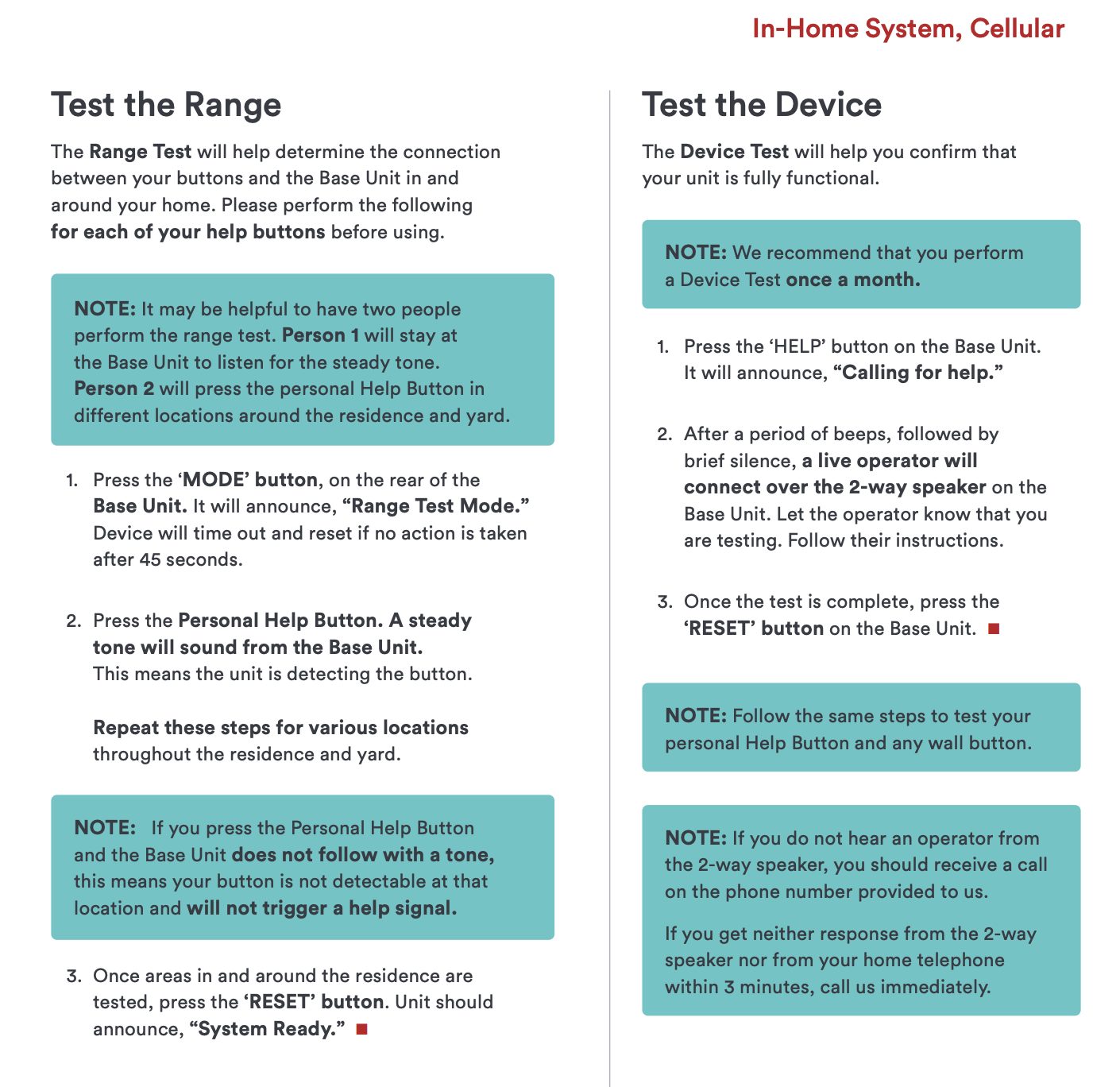
By testing your bracelet’s connection to the base station both inside and outside your home, you’ll know the maximum distance you can go from the base station before you lose the connection.
Another of our favorite features is the colorful “Bella Bands” wristbands. Bay Alarm Medical offers this optional accessory to brighten up your medical alert bracelet. To wear and use the Bella Band, you place the help button included with your base station in the center of the elastic band. The colorful bracelet works the same way as the standard medical alert bracelet.

I ended up getting my mother a purple wristband for the Bay Alarm wrist unit. I think it kind of matched her Fitbit and got her to like that the bracelet blends in a little bit … It made the bracelet look like something she would naturally wear.
Focus group participant
We are also impressed with the strength of the base station speaker. The loud, powerful speaker allows us to speak with the monitoring agent from more than five feet away during test calls.
Fall detection isn’t available for this bracelet. Like most at-home medical alert systems, you’ll need to purchase a separate pendant for fall detection. Fall detection costs the typical $10 per month, but there’s also a $30 one-time fee for this feature.
While we don’t like this extra one-time fee, the SOS Home was the most accurate fall detection device during our testing. It was the only system to detect all three slow and all three fast falls.
Why Bay Alarm Medical is our choice as the best overall
In addition to the SOS Home system’s easy setup, simple design, and impressive fall detection, we like that Bay Alarm Medical offers other options besides a black or white medical alert bracelet. Consider the SOS Home if you want a stylish pop of color to motivate you to wear your medical alert bracelet. The wristbands are available in four colors: midnight, sky, mint, and lavender. They’re $17 each or four for $60.
Bay Alarm’s stylish accessories aren’t limited to their bracelets—you can also upgrade your medical alert necklace with Bella Charms.
Keep in mind that the colorful Bella Bands are for at-home bracelets only. This means you can use your medical alert bracelet in and around your home, but not on the go.
Easiest to use: Medical Guardian MGMini Lite
Our verdict
The MGMini Lite is a discreet, comfortable medical alert bracelet without distracting smartwatch features. We are impressed by the bracelet’s sensitive fall detection, accurate GPS tracking, and step tracking.
Insights from our testers
We immediately notice how lightweight the MGMini Lite feels around our wrists compared to other medical alert bracelets and watches we test; the watch face weighs less than an AA battery. The bracelet looks similar to an Apple Watch, but instead of a touchscreen and endless features, the MGMini Lite keeps it simple with a help button and two-way speaker.
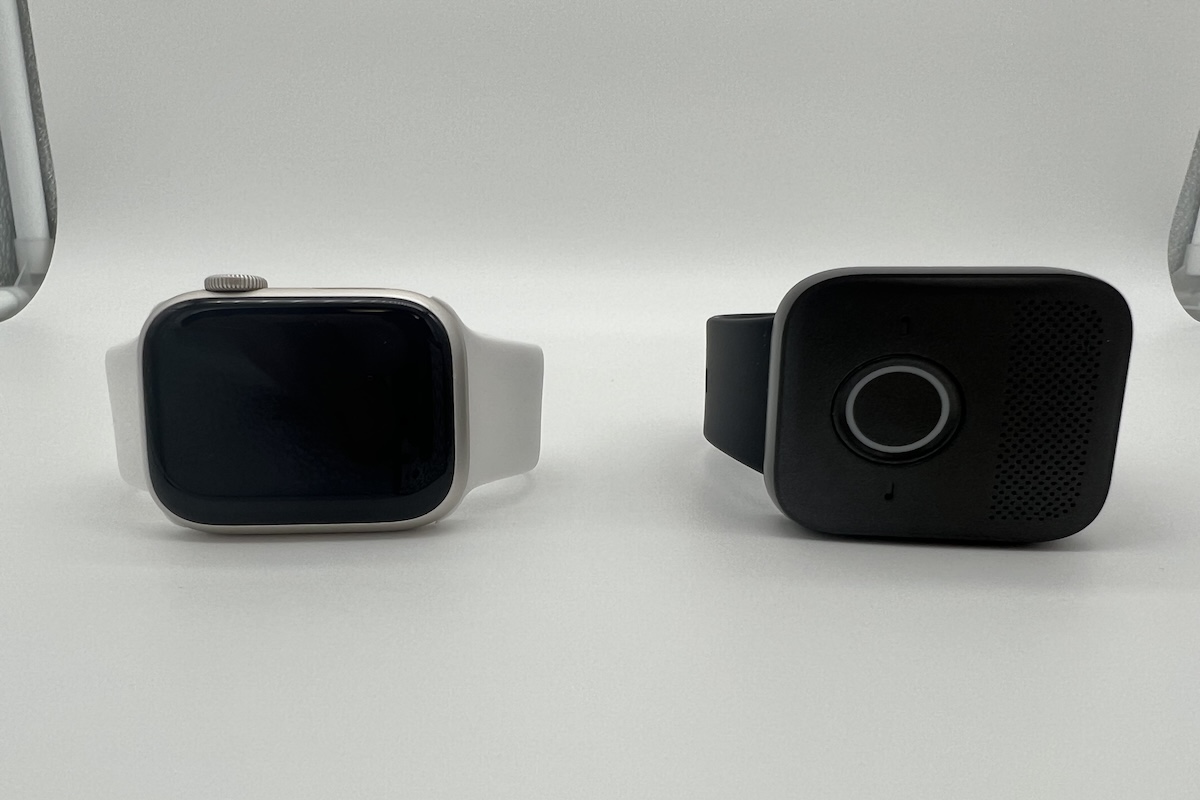
The MGMini Lite detected five out of six test falls. Accurate fall detection is impressive for a medical alert bracelet since research shows the best placement for accurate fall detection is on the chest, like a device worn as a necklace.
The Handbook Team also conducts multiple test calls to the monitoring center using the help button. We spoke with a friendly agent who confirmed our correct location each time we called.
On-the-go medical alert systems have GPS tracking, which allows monitoring center agents to dispatch emergency services to your location. Accurate GPS location tracking is a crucial feature for emergencies outside your home.
Why Medical Guardian is our choice as the easiest to use
The Medical Guardian MGMini Lite stands out for its simple, straightforward design and discreet appearance—it’s our favorite Medical Guardian device and one of our favorite medical alert watches. The on-the-go bracelet is easily disguised as a smartwatch or fitness tracker without the extra features; it has a help button and speaker—and that’s it.
We are impressed with the bracelet’s sensitive fall detection (it detected five out of six test falls), accurate GPS location tracking, and a two-way speaker to communicate with a monitoring center agent.
Lowest starting price: MobileHelp Classic
Our verdict
The MobileHelp Classic is a basic at-home system that costs less than $25 per month. We like this affordable option for anyone who needs a medical alert bracelet in and around their home.
Insights from our testers
The MobileHelp Classic is an at-home system that includes a medical alert bracelet and necklace. We are impressed with the system’s simple setup instructions and appreciate the large font and pictures that guide us through each step. You’ll choose between a white or black bracelet with an adjustable band.
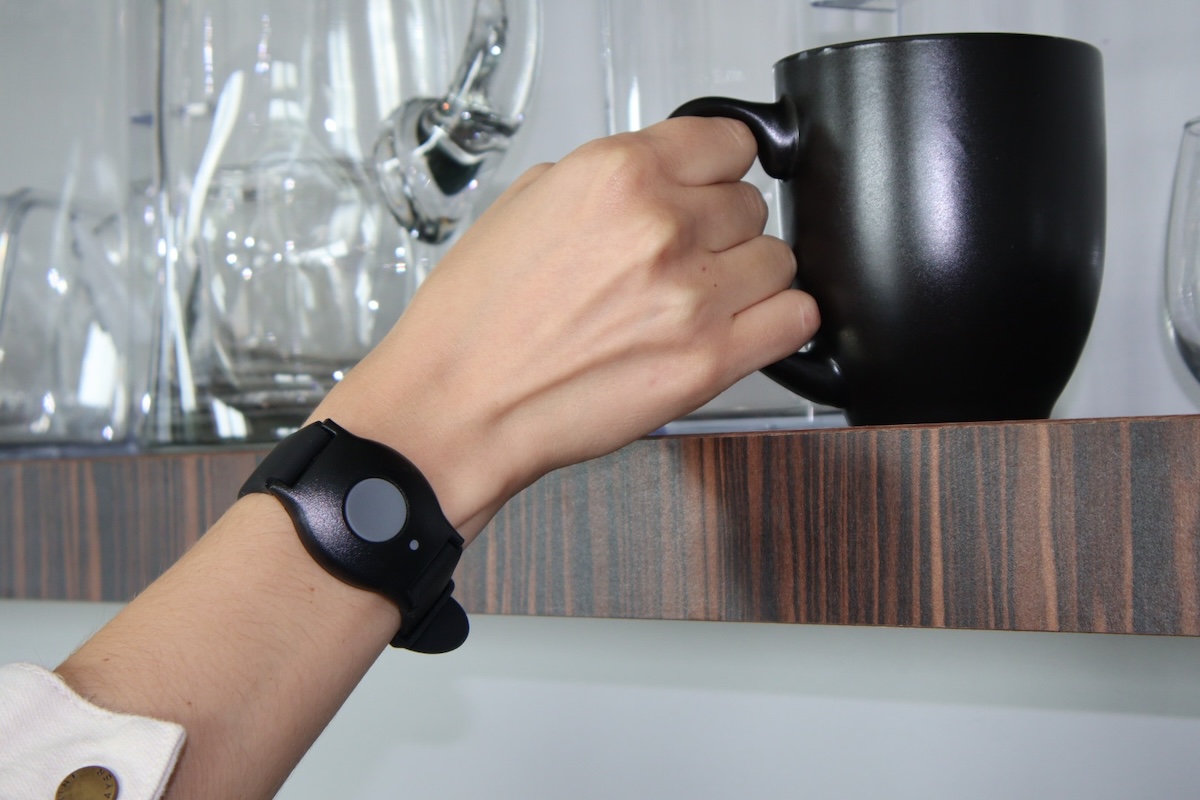
Whenever we contacted the monitoring center, the agents were friendly and responsive. We like that the agent always asked if anyone else needed help after we confirmed that we were testing the device. Unfortunately, our base station speaker is low-quality, and the monitoring center agent’s voice is sometimes difficult to understand.
From our tester
“The speaker sounded a little garbled when a monitoring center agent spoke with us through the base station.”
Fall detection isn’t available for this bracelet. If you want fall detection with the MobileHelp Classic, you’ll need to purchase a separate fall detection necklace This necklace has a built-in sensor to detect downward motion. If the necklace detects a fall, it automatically contacts the monitoring center. for $11 per month. Although this is more expensive than the average $10 per month, we think the Classic has one of the most accurate fall detection necklaces; it detected five out of six test falls.
Why MobileHelp is our choice as the lowest starting price
The MobileHelp Classic is impressively priced at $24.95 per month. Not only is $24.95 the lowest starting price in this review, it’s also one of the lowest monthly fees out of the 10 medical alert brands we tested.
We also like that you can monitor multiple people in the same home for a couple more dollars per month. Each additional medical alert bracelet is $2 per month, meaning two people can access the 24/7 monitoring center for only $11 per month, per person.
Best for check-in services: LifeFone At-Home Cellular
Our verdict
The LifeFone At-Home Cellular is a standard at-home system with optional check-in and reminder services. We don’t recommend this system for fall detection, but we like that extra bracelets are available as a one-time fee instead of a monthly fee.
Insights from our testers
The LifeFone At-Home Cellular system includes a base station and medical alert bracelet or necklace. We are pleased with the user manual’s large, easy-to-read text and images that label what each light and button on the base station means.
Setting up the device is quick and simple: The base station connected to the cellular network in less than 30 seconds after we plugged it in, and the monitoring center picked up after one ring when we called to activate the device.
From our tester
“I like that there’s a page in the back of the instruction manual for users to write notes. I know my grandparents would love that.”
Our testers are impressed with the base station speaker volume. After pressing the bracelet help button from across the room, we spoke with a monitoring center agent more than six feet from the base station. A powerful speaker is helpful so you can still communicate with an agent during an emergency even if you aren’t right next to the base station.
LifeFone also sends a text message if the base station is unplugged or loses power. If the batteries in your base station or medical alert bracelet are low, the company calls the user or caregiver to notify them. The company replaces your bracelet for free when the battery is low.
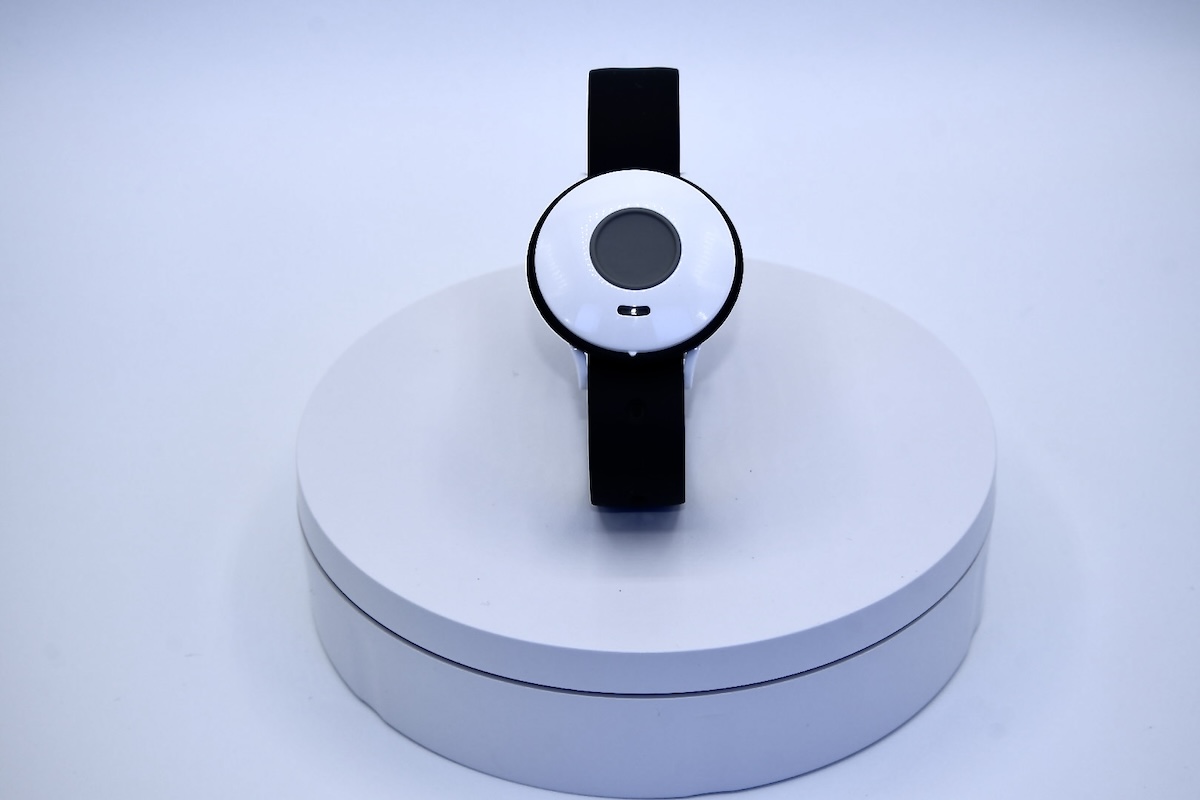
Fall detection isn’t available for this bracelet. A fall detection necklace is available for $5 per month, half the cost of most brands. Unfortunately, we think the low price reflects the fall detection sensor’s poor quality. The necklace detected only one out of three slow falls, but it did detect all three fast falls.
Why LifeFone is our choice as the best for check-in services
Some medical alert systems, including LifeFone, offer extra features on top of 24/7 monitoring center access. The brand has daily check-in and reminder services for users and caregivers who may want more consistent monitoring. A monitoring center agent calls the user’s house phone or cell phone at a scheduled time each day to check in and see how they’re doing. We like that you can customize this call to include medication or other task reminders.
We recommend this service if your primary caregivers live out of town or if you need detailed daily reminders. However, at $19 per month, this service may be a steep cost on top of the monthly monitoring fee. Consider the activity assurance feature for a simpler, less costly check-in service ($6 per month). Instead of receiving a check-in call from the monitoring center, the base station prompts you to press a button at the same time each day as a check-in.
Keep in mind that medical alert systems should never replace in-person caregiving. “While medical alerts can help provide peace of mind, families should not solely rely on medical alert systems,” says Lakelyn Eichenberger, PhD, gerontologist and caregiving advocate at Home Instead. “They need to continue to regularly check-in on their family members and ensure they have the proper amount of care and assistance. They can even consider professional home care to help supplement when the family is not available.”
What to consider when purchasing medical alert bracelets
What to consider when purchasing medical alert bracelets
The best medical alert bracelet for you depends on your lifestyle, personal preferences, and budget. We recommend keeping these key features in mind while shopping to help with your decision:
- Type of system: Do you only need a bracelet in and around your home? Or would you also like to call the monitoring center on the go? Consider your lifestyle when choosing between an at-home or on-the-go bracelet.
- Range and connection: The range indicates how far you can be from your at-home system and still connect to the monitoring center. Most medical alert systems use AT&T or Verizon cellular service to connect to the monitoring center. If your area has poor cellular service, consider an at-home system with a landline connection.
- Fall detection: While fall detection doesn’t prevent falls, this feature automatically connects you to the monitoring center after a fall, even if you can’t push the help button.
- Comfort: Your medical alert bracelet should fit comfortably on your wrist, so make sure it’s adjustable. Most bracelets are either black or white, but some brands, such as Bay Alarm Medical, offer accessories to make them colorful and stylish.
- Battery life: Most medical alert bracelets that pair with a base station have multi-year batteries. If you’re considering an on-the-go system, review the device’s battery life and how long it takes to recharge.
- Waterproof The device can be submerged in water for a long time and still function properly. or water-resistant The device can get splashed with water and still function properly, but it shouldn’t be submerged. : Most medical alert bracelets are waterproof, which is great if bathing or swimming with your bracelet is important to you. The MGMini Lite, like most on-the-go devices, is water-resistant. While you can’t submerge the device, you can wear it in the shower, while exercising, or when it’s raining.
Whether the person is more likely to wear a pendant necklace, bracelet, or a watch really comes down to a matter of personal preference. The most important thing is that the individual actually wears the device and that it does not sit on the nightstand or in a drawer.
Lakelyn Eichenberger, PhD, gerontologist and caregiving advocate at Home Instead
Frequently asked questions
The medical alert bracelet calls a 24/7 monitoring center when you press the help button. An agent will contact emergency services, your primary emergency contact, or both. If the agent can’t hear you or you’re unresponsive, they’ll automatically send emergency services to your location. Medical alert bracelets can be a standalone device or connect with an at-home or on-the-go system. Depending on the device, the bracelet connects to the monitoring center using a landline or cellular network connection.
No, Original Medicare (Parts A and B) doesn’t cover medical alert bracelets. Medicare Advantage (Part C) may cover full or partial medical alert costs, but coverage varies by insurance plan and state. Always check coverage details with your health insurance provider.
Most medical alert bracelets cost about $20–$40 per month. Some bracelets, like Medical Guardian MGMini Lite, have an extra one-time equipment fee. Most medical alert companies also allow you to purchase additional bracelets for $2–$4 per month, or a $30–$40 one-time fee.
- Stokke, Randi. (2016). The Personal Emergency Response System As a Technology Innovation in Primary Health Care Services: An Integrative Review. Journal of Medical Internet Research, 18(7). Link
- Lee, Y., Pokharel S., Al Muslim, A., KC, D.B., Lee, K.H., and Yeo, W.H. (2023). Experimental study: Deep learning-based fall monitoring among older adults with skin-wearable electronics. Sensors, 23(8), 3983. Link



